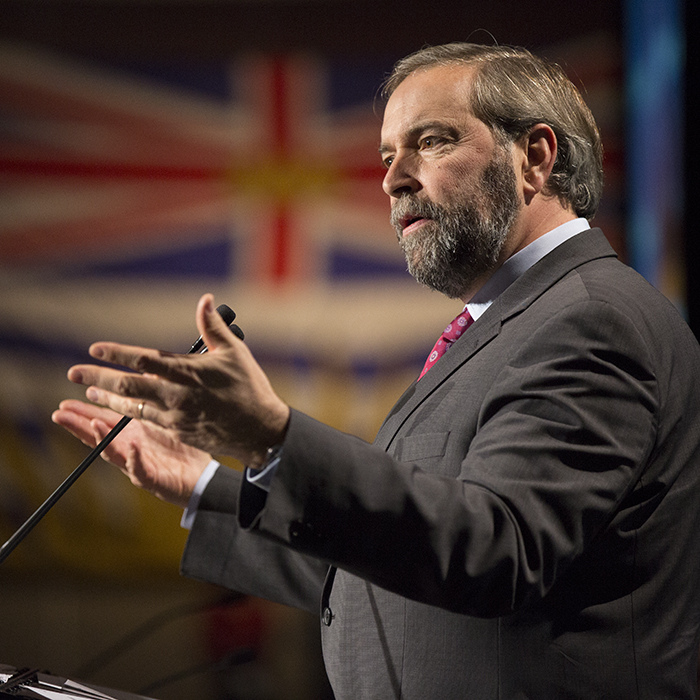Like our environmental coverage? Chip in to keep stories like these coming.
Tom Mulcair is currently the only leader of the three major parties proposing a clear approach to tackling climate change: cap-and-trade. This is not a new position for the NDP — it was also included in the NDP platforms for the 2008 and 2011 federal elections.
In fact, the Conservative Party was also a supporter of cap-and-trade in the 2008 election, but reversed its position in 2011. According to a 2012 Maclean’s article, “A Rough Guide to the Conservatives’ Carbon Tax Farce,” “No explanation has been offered for how the Conservatives went from proposing cap-and-trade to opposing cap-and-trade.” Ottawa insiders suggest, however, that this was a personal decision of Prime Minister Stephen Harper.
A 2012 Forbes magazine article, “Cap and Trade Curbed Acid Rain: 7 Reasons Why It Can Do the Same for Climate Change,” recalls that only a few days after taking office in January 1990, U.S. President George Bush (the first one) said, “The time for study alone has passed, and the time for action is now.” Within five months, his administration had prepared amendments to the U.S Clean Air Act to create an emissions trading system for sulfur dioxide (the main pollutant causing acid rain), which became law in November 1990.
The Organization for Economic Cooperation and Development (OECD) has been analyzing and promoting the use of market-based instruments such as emissions trading for many years. An OECD brief on emissions trading systems says: “In a cap-and-trade system, an upper limit on emissions is fixed, and emission permits are either auctioned out or distributed for free according specific criteria.” The OECD recommends auctioning permits, so as to ensure that revenue generated in a cap-and-trade system “goes to public authorities, instead of being captured by the existing polluters.”
Mulcair has not provided all the details of the cap-and-trade system his government would implement. This is wise, for several reasons. First of all, federal government officials presumably studied how cap-and-trade could work in Canada during the time that the Conservatives were considering implementing a system. A new government might benefit from dusting off this research. Second, as Mulcair has noted, some provinces already have implemented (or intend to implement) systems to put a price on carbon pollution. Discussions with these provinces will help inform a national system.
Perhaps most importantly, over 190 other nations have, like Canada, ratified the UN Framework Convention on Climate Change, pledging to stabilize greenhouse gas concentrations and prevent “dangerous” human interference with the climate. While expressing general support for cap-and-trade, Canada would be well advised to reserve its detailed positions and maintain flexibility for the upcoming negotiations at the Paris Climate Conference this December. The Conference may re-ignite interest in broader international carbon markets, and participation in these could have benefits for Canada.
Mulcair has acknowledged that provincial carbon taxes, such as British Columbia’s, can be part of a national system. A CBC article quotes him as saying if “they’re getting the result that you’re hoping for, you don’t move in and replace it — you bring it in.” The OECD also recognizes that environmental taxation can be “efficient and effective” as a means of reducing pollution, much like emissions trading. Either a carbon tax or cap-and-trade puts a price on carbon pollution, the key step in achieving reductions.
Why, then, focus on cap-and-trade? Why not a national carbon tax, such as the one proposed by the Liberals during the 2008 election (but later abandoned) or the “carbon fee and dividend” system currently favoured by the Greens? Politics aside, one clear argument for cap-and-trade is that, unlike a carbon tax, it provides certainty about the upper limit of emissions. A carbon tax provides more certainty about the cost of reducing emissions, but the 2012 Forbes article predicts that, based on experience with sulfur dioxide, cap-and-trade will likely cost less than expected.
By actively championing cap-and-trade for addressing climate change, Mulcair and the NDP have seized the initiative on the most important environmental issue in the current federal election.
Ole Hendrickson is a retired forest ecologist and a founding member of the Ottawa River Institute, a non-profit charitable organization based in the Ottawa Valley.
Photo: bcndp/flickr
Like our environmental coverage? Chip in to keep stories like these coming.




